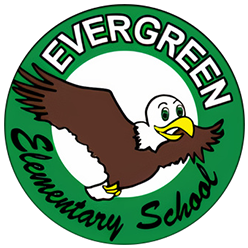Art

Welcome to Evergreen Art
Art: Grades K-4
It's an exciting year! We are learning and growing in the Art Room.
We are implementing Choice Based Art Education / Teaching for Artistic Behavior.
Check out the info below for more about what's happening in the Art Room!
MATERIAL DONATIONS NEEDED
Please feel free to send in any of the materials listed below so that we can continue to make wonderful original works of art! If you aren't sure if we can use it - please call or email me and I'll let you know!
Toilet paper or paper towel rolls
Scrapbook paper
Craft materials (NO GLITTER PLEASE)
Small wood scraps
Legos
Wooden Blocks
What's Happening at Evergreen Elementary
IDEA -> PLAN -> MAKE -> SHARE
In a Choice Based Art Education curriculum students work through the artistic process. The student artist is responsible for coming up with an idea of what they would like to create (sometimes the teacher may present an artist or technique as a source of inspiration). Next they need to come up with a plan as to how to make their idea a reality (or how to get what's in their head out on paper). The student must choose what materials will work best to create their idea. They use the materials to make their art while working to solve any problems that may arise. Finally, upon completion of the artwork, students reflect and write Artist Statements about their work. If they want, they also have the opportunity to share their artwork with the class. All artwork and artist statements are then photographed, typed and uploaded to Artsonia. Check out our online art gallery link! Artsonia - Evergreen Elementary
Studio Centers
Drawing
The Drawing Center gives students the opportunity to experiment with and use a wide variety of media. Students can choose from pencil, colored pencil, crayon, markers, chalk, and oil pastels.
Collage
The Collage Center gives students the opportunity to cut and glue different papers as well as incorporate other drawing or painting materials to make a mixed media artwork.
Painting
In the Painting Center students have the opportunity to work with watercolor paints or tempera paints. They are taught skills such as color mixing and creating tints and shades.
Sculpture
Students work with various types of cardboard, paper, recyclable materials, and found objects to create a 3-dimensional work of art. Limited Center.
Fiber Arts
Students work on basic weaving and simple hand sewing skills while creating artworks using yarn and fabric.
Clay
Students are guided to create a clay artwork such as a pinch pot, relief sculpture, or hand built sculpture with the option to paint or glaze their piece. Limited Center.
Printmaking
Students learn to use tools and materials such as stamps or foam plates to create an image that can be repeated or printed multiple times.
Architecture
Students use wooden planks and plastic and foam shapes to create buildings, structures, or solve engineering challenges.
Studio Habits
Students are also working through the 8 Studio Habits of the Mind as they are working as artists. Almost every one of these habits occurs naturally throughout the creation of their artwork and their written artist statement.
Develop Craft: As a result of participating in art class, students acquire the skills or techniques needed to work with various media.
Engage and Persist: Students are taught to engage in a project, focus on a task for a sustained period of time and persist with their work.
Envision: Students are taught to generate mental images that will help guide their work and use their imagination to think of new ideas and forms.
Express: Students are meant to learn to go beyond craft to convey a personal vision and meaning in their work. This habit of mind includes making works exemplify a property that is not visible such as mood or atmosphere.
Observe: Students are taught to look closely at their own works (the color, line, texture, forms, structure, expression, and style), at others works (whether by their peers or by professional artist), and the world (when they are working from observation) and to notice things they might have otherwise missed.
Reflect: Students are asked to think about and explain their process, intentions, and decisions. They are also asked to judge their own work and that of others.
Stretch and Explore: Students are expected to try new things, to explore, take risks, and capitalize on their mistakes.
Understand Art World: Students in visual arts classes learn about art history and the practicing art world today and their own relationship to today’s art world.
From Studio Thinking by Lois Hetland
